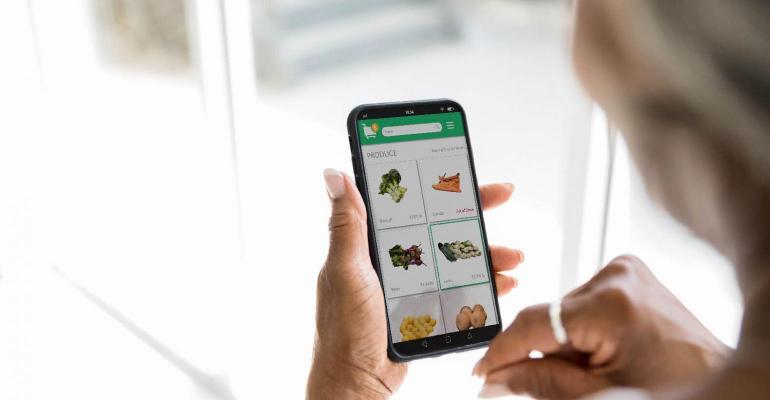Don Swalinski is Vice President of Digital Customer Experience (DCX) at Capgemini Americas. He works with all sectors, applying their industry-specific needs into the CX space. Don’s expertise spans multiple industries, including consumer product and retail, digital manufacturing, electronics and high tech, aerospace and defense, automotive, and media and entertainment, among others. He is based in Orlando, Fla.

The grocery industry has spent the last year and a half building and optimizing its e-commerce business and managing incredible growth. For many retailers, growth in online sales has led them to assume that everything they’re doing aligns with what their customers want. However, it’s important to remember that —as much as grocers have accomplished under pressure — much of the boom in online grocery shopping was driven by necessity.
The food and beverage category outpaced all others in online sales growth in 2020. Although the sense of necessity for buying online has diminished in some regions, Forrester projects that online food and beverage sales will continue to grow faster than any other category through at least 2024, when food and beverage will represent 17% of total U.S. e-commerce sales.
Those figures mean it’s a good time for grocery retailers with e-commerce platforms to see what’s working well for customers and identify areas for improvement and innovation. It’s also a good time for grocers that have relied on third-party delivery services since the start of the pandemic to invest in their own commerce platforms so they can access and use customer data to enhance customer experience (CX), drive more valuable interactions, and increase brand loyalty.
CX challenges facing grocery retailers now
Leading players in the online grocery space have set a high bar for customer expectations in terms of low-friction checkout, fast delivery, clarity about delivery times and consistency of the customer experience. Local and regional grocers need to deliver a similar level of convenience and reliability to win and keep their online customers.
Another challenge is dealing with stockouts and substitutions. Grocers offer so many products that are affected by many variables that it’s always possible that a customer’s selections will be out of stock. Some grocers replace the out-of-stock item with a similar product and charge the original product price, while others charge the price of the replacement item. Some grocers let customers specify their preferred substitutions before they place their order, and others contact the customer when a product is out of stock.
The ideal approach is the one that meets customers’ needs and is cost-effective. For example, if customers get upset that a substituted item costs them more, the company may spend more on customer service than they made on the sale of that item. Contacting each customer about substitutions can improve individual customer experiences but might bog down fulfillment times and cause an overall CX decline.
The next big opportunities for CX improvement
A major opportunity in grocery e-commerce now is the capability to use customer data and feedback to improve the experience. There’s also a big opportunity for grocers to differentiate by developing a customer service specialty that appeals to their core audience.
Data from the e-commerce platform and customer surveys can show retailers how customers want the store to deal with substitutions. So, for example, a retailer might learn that most of its customers prefer to speak to a representative at the store when a substitution is required. That finding can lead the grocer to adjust the picking process to factor in time for an employee to contact the customer, so the customer is delighted and so substitutions don’t create a bottleneck that slows down order picking.
Depending on the retailer’s customer base, they might decide to go a step further and create a personal shopper-style experience. For example, they might assign specific pickers to each customer’s account and facilitate communication among them. With access to the customer’s purchase history and the ability to contact customers with questions, these employees would be able to serve customers better, give customers confidence that they will get items they want and help the retailer carve out a niche to differentiate itself.
Analyzing data and customer feedback can also help grocers decide how to allocate their e-commerce resources. For example, it’s easy to assume that all grocery store shoppers want their items as fast as possible. However, some grocers are finding that their customers prefer delivery during a one-hour window on a specific day, even if that means waiting longer for the order to arrive. With that knowledge, those retailers can shift their offerings and adjust their delivery levels to give customers what they want.
E-commerce offers opportunities for grocers to work with brands and create digital versions of the kind of in-store endcap promotions that raise margins and drive revenue. For example, one grocer features recipes on their e-commerce site that include specific brands' products. When customers click to add a recipe’s ingredients to their cart, those branded products are included by default.
A solid customer data foundation
Even though e-commerce technology is evolving quickly in the grocery space, listening to customers is still fundamental. When creating or improving an e-commerce platform, a good analysis of customer behavior and feedback can help retailers avoid guesswork and costly mistakes. Retailers with ongoing insight into how their customers prefer to search, shop, choose substitutions and take deliveries can continuously optimize the e-commerce experience. That can enhance customer loyalty, increase average ticket value and shopping basket conversions, and perhaps even carve out a customer-service niche that sets them apart from the competition.





